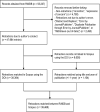Linking citation and retraction data reveals the demographics of scientific retractions among highly cited authors
- PMID: 39883670
- PMCID: PMC11781634
- DOI: 10.1371/journal.pbio.3002999
Linking citation and retraction data reveals the demographics of scientific retractions among highly cited authors
Abstract
Retractions are becoming increasingly common but still account for a small minority of published papers. It would be useful to generate databases where the presence of retractions can be linked to impact metrics of each scientist. We have thus incorporated retraction data in an updated Scopus-based database of highly cited scientists (top 2% in each scientific subfield according to a composite citation indicator). Using data from the Retraction Watch database (RWDB), retraction records were linked to Scopus citation data. Of 55,237 items in RWDB as of August 15, 2024, we excluded non-retractions, retractions clearly not due to any author error, retractions where the paper had been republished, and items not linkable to Scopus records. Eventually, 39,468 eligible retractions were linked to Scopus. Among 217,097 top-cited scientists in career-long impact and 223,152 in single recent year (2023) impact, 7,083 (3.3%) and 8,747 (4.0%), respectively, had at least 1 retraction. Scientists with retracted publications had younger publication age, higher self-citation rates, and larger publication volume than those without any retracted publications. Retractions were more common in the life sciences and rare or nonexistent in several other disciplines. In several developing countries, very high proportions of top-cited scientists had retractions (highest in Senegal (66.7%), Ecuador (28.6%), and Pakistan (27.8%) in career-long citation impact lists). Variability in retraction rates across fields and countries suggests differences in research practices, scrutiny, and ease of retraction. Addition of retraction data enhances the granularity of top-cited scientists' profiles, aiding in responsible research evaluation. However, caution is needed when interpreting retractions, as they do not always signify misconduct; further analysis on a case-by-case basis is essential. The database should hopefully provide a resource for meta-research and deeper insights into scientific practices.
Copyright: © 2025 Ioannidis et al. This is an open access article distributed under the terms of the Creative Commons Attribution License, which permits unrestricted use, distribution, and reproduction in any medium, provided the original author and source are credited.
Conflict of interest statement
JB is an Elsevier employee. Elsevier runs Scopus, which is the source of these data, and also runs the repository where the database of highly-cited scientists is now stored.
Figures


Similar articles
-
Publication rates after the first retraction for biomedical researchers with multiple retracted publications.Account Res. 2019 Jul;26(5):277-287. doi: 10.1080/08989621.2019.1612244. Epub 2019 May 14. Account Res. 2019. PMID: 31025884
-
Research misconduct in health and life sciences research: A systematic review of retracted literature from Brazilian institutions.PLoS One. 2019 Apr 15;14(4):e0214272. doi: 10.1371/journal.pone.0214272. eCollection 2019. PLoS One. 2019. PMID: 30986211 Free PMC article.
-
Evolution of retracted publications in the medical sciences: Citations analysis, bibliometrics, and altmetrics trends.Account Res. 2024 Nov;31(8):1182-1197. doi: 10.1080/08989621.2023.2223996. Epub 2023 Jun 16. Account Res. 2024. PMID: 37309726
-
The continued citation of retracted publications in dentistry.J Med Libr Assoc. 2020 Jul 1;108(3):389-397. doi: 10.5195/jmla.2020.824. J Med Libr Assoc. 2020. PMID: 32843870 Free PMC article.
-
An examination of retracted articles in nursing literature.J Nurs Scholarsh. 2024 May;56(3):478-485. doi: 10.1111/jnu.12952. Epub 2023 Dec 20. J Nurs Scholarsh. 2024. PMID: 38124265 Review.
Cited by
-
Thousands of highly cited scientists have at least one retraction.Nature. 2025 Feb;638(8050):306. doi: 10.1038/d41586-025-00257-2. Nature. 2025. PMID: 39890909 No abstract available.
-
Features and signals in precocious citation impact: A meta-research study.PLoS One. 2025 Aug 6;20(8):e0328531. doi: 10.1371/journal.pone.0328531. eCollection 2025. PLoS One. 2025. PMID: 40768479 Free PMC article.
References
-
- Marcus A, Oransky I. Is there a retraction problem? And, if so, what can we do about it? In: Kathleen Hall Jamieson Dan M Kahan DAS, editor. The Oxford Handbook of the Science of Science Communication. Oxford University Press; 2017.
MeSH terms
LinkOut - more resources
Full Text Sources

